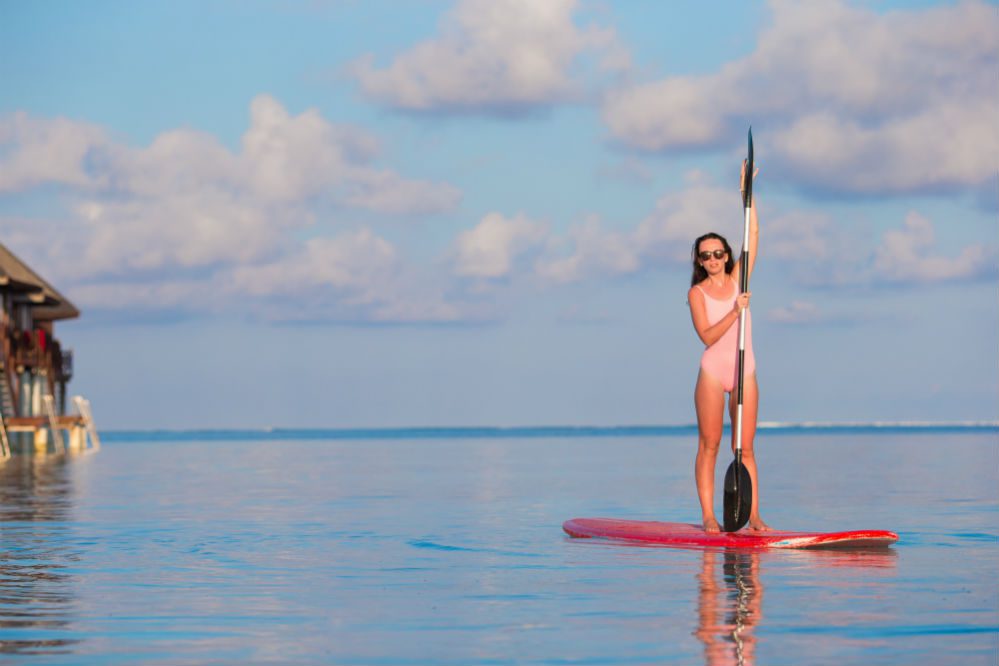
Stand-up paddleboarding or SUP is a fun activity that can be done on lakes, rivers, bays, and oceans—basically all bodies of water. It is a great way of seeing the beauty of nature and at the same time getting a full-body workout that targets the core.
This article offers basic information about paddleboards and how to paddleboard as beginners.
Contents
Different Types of SUPs
For beginners, using a thicker, wider, and longer board is advisable. This kind of paddleboard offers optimum stability. The all-around board is ideal for new paddlers, but there are other types of paddle boards available as well.
- All-around Paddleboard
Perfect for beginners, this type of paddleboard can be used in any type of water conditions. The all-around paddleboard can be used on calm lakes and wavy oceans and is stable enough for other paddleboarding activities like SUP fishing, yoga, and surfing.
- Inflatable Paddleboard
This is another great SUP for beginners. It is the best choice for travel and when you do not have enough room to store an all-around SUP or other SUP types. It is very durable and won’t get damaged even when dropped.
- Fishing Paddleboard
The deck pad of a fishing SUP is expansive, therefore giving you more space for your fishing gear. Some fishing SUPs have attachments such as bait trays and fishing rod holders. While it is primarily used for paddleboard fishing, this type of SUP is also a good choice for beginners.
- Yoga Paddleboard
Like the fishing SUP, a yoga paddleboard is wider, thus allowing you to execute your yoga poses. Apart from conventional yoga SUPs, there are also inflatable ones that are favored by many yoga enthusiasts because they are more stable than other types of SUPs. This type of board is also a top choice for beginners.
- Touring Paddleboard
This longer and narrower SUP has a pointed nose and is ideal for long-distance adventures. For better tracking, touring paddleboards are usually equipped with displacement hulls.
- Surf Paddleboard
This type of paddleboard is the least stable of all, which means that it would be challenging for a beginner to use it. It is specially designed to be responsive and maneuverable in the surf.
- Racing Paddleboard
This is the longest type of paddleboard, and it is designed as such so that it can support fast and efficient gliding. Not advisable for beginners, a racing paddleboard is specifically made for race competitions.
How to Paddleboard: A Beginner’s Guide
For those who are new to paddleboarding, this activity may look rather challenging, but with proper training and practice, anyone can do this. By following this guide, you will know how to paddleboard in no time.
Step 1 – Standing up on a SUP
Here is a step-by-step guide to standing up on a paddleboard:
- Walk into the water until it’s about knee-deep
- Place your paddle across the paddleboard, toward the nose
- Place one knee slowly on each side of the paddleboard. Your knees should be straddling the handle hole of the board, and you should be facing forward
- Spread your knees about one foot apart and adjust as you balance. You are now in a pony ride position
- Place your hands directly in front of your knees; each hand should be on the paddle shaft with the fingers spread wide
- Bring one foot up as you press your fingertips on the board deck. Place your hand where your knee was located. Repeat on the other side. Stand up slowly, bringing the paddle with you and using it to help you balance.
- Once you feel that you are comfortable and balanced, slowly straighten and make your back upright but keep your knees bent
- Use your toes to adjust your position little by little until you find the most comfortable upright position for you
- With the bent part facing forward, place the paddle in the water. It will now act as your third leg and give you more stability
- Remember that you may fall off while trying to stand up. When you do fall, hop back and try again
Step 2 – Learning Paddling Techniques
There are a few techniques on paddling, and each of these techniques makes use of the paddle as a lever. Now that you are already standing on the board with feet apart and knees bent slightly, you are now ready to move around. Here’s how you can do that:
- Bend your knees. Use your legs to absorb shock, and balance your body against any water movement
- Keep your eyes on the horizon and do not look at your feet
- Keep your head erect and shoulders straight with hips parallel with your shoulders. Do not stick out your butt.
- Start paddling slowly and feel the momentum improve your stability.
Step 3 – Moving Around
When making a left turn, place the paddle on your right side and paddle as you turn your torso to your left. Keep your posture low and then pull to the right while twisting your torso to the left. The board will quickly shift to the left.
When turning right, position the paddle near the board’s tail, pulling to the nose while turning your torso to your right. This will cause the board’s nose to spin to the right.
Remember it is easier to turn the board when you keep your knees bent. The general rule is, when you paddle on the right side, the paddleboard will turn to the left, and when you paddle on the left, you’ll turn to the right. If you want to reverse direction fast, paddle backward.
Paddleboarding Do’s and Don’ts
Here are some tips to make sure you get the best out of your paddleboarding sessions:
Dos
- When holding the paddle, place one hand on the top and your other hand on the shaft
- Spread your feet shoulder-width apart, with your feet parallel and your toes pointing to the board’s nose
- Keep your paddle grip shoulder-width apart. Immerse the paddle blade completely into the water
- Let your back muscles do the paddling
Don’ts
- Avoid placing both of your hands on the shaft of the paddle. Don’t hold it like a broomstick
- Do not stand as if you are surfing. First, it might cause you to fall, and second, it will make paddling harder
- Do not rely only on your arms when paddling. Doing this will tire you fast
Final Thoughts
As a first-timer, you must be prepared to fall. Falling off the board is part of the learning process. Therefore, you must remember that the water should be deep enough to keep you from hitting the ground when that happens.
As you learn these techniques and gain experience, falling off the board will be less often. And then you will surely learn to love paddleboarding and enjoy its benefits soon!
